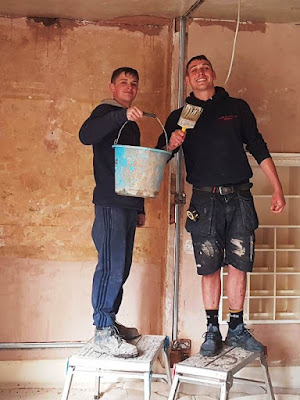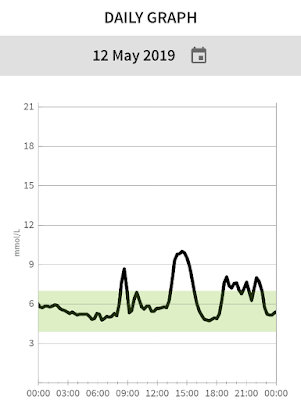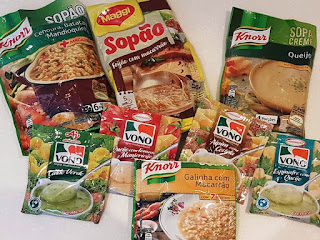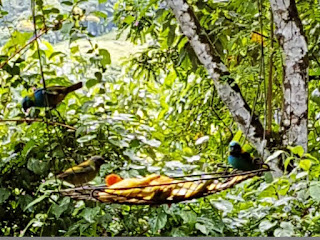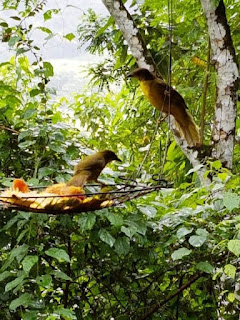 |
| Forest camp, Amazonia, April 2019 |
Without doubt, the middle section in Amazonia was the best part of the holiday. Not just because of the setting and the sights, but because of the people that I met. Seven of us were booked to start the organised trip at the same time, but four of us were there for three days, two for four days, and only me for the five day option.
But before that trip started I was collected at Manaus airport and taken to my accommodation that night: an actual hostel, the sort that proper backpackers use (although I had a private room, with en suite and aircon! Bliss!) At reception I was asked if I was a backpacker, and I didn't know what to say. Does a rucksack instead of a suitcase qualify you to be a backpacker? If so, then yes I am! If staying in a hotel in Rio and then a private room in a hostel disqualifies you, then no. They also took a photo of me at reception. I imagine it's handy in case you don't come back from some ill advised excursion that backpackers might choose to go on.
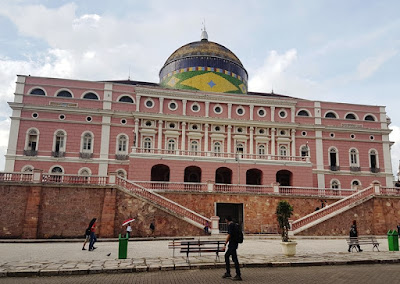 |
| Teatro Amazonas, Manaus |
There was still some daylight left so I wandered down to the port and the produce market, but it was hotter and even more humid than Rio, too late for much produce to be on display, and it didn't feel like a very safe part of town. It was also too late to explore the magnificent Teatro Amazonas opera house. I was told that the city was booming since President Bolsonaro had taken office because of industry incentives, but the centre was still shabby and didn't seem to be very prosperous. Then I had some packing to do, because I was going to leave a whole lot of stuff in the tour office while I was on my Jungle Adventure.
I was collected early next morning. The first leg of the trip was a 40 minute car drive out of town to the ferry which would take us across the 'meeting of the waters' (Encontro das Aguas) - where the black Rio Negro meets the brown Amazon and the waters don't mix. If it hadn't been pouring with rain then the boat's plastic windows wouldn't have been firmly lashed down and we might have had a better view, but I got the idea and it was fairly impressive despite the limitations. There are many good pictures on the Internet if you have a look.
 |
| The end of the road |
On the other side a van was waiting to take us to the end of the road, which took about an hour. It did stop raining at this point, but no let up from the heat and humidity, and this was the last point for five days that I had a soft seat to sit on. At the end of the road we were taken by boat to the Juma Lake Inn, where lunch was waiting. Meals comprised rice, beans with chicken or fish and sometimes salad or vegetables or fruit. It wasn't fancy but it tasted fine. Not being a coffee drinker, I was limited to water - not just for this section of the trip but pretty much for two whole weeks, apart from a few bowls of Redbush tea towards the end (I had to use a bowl because T's coffee cups were too small).
I should introduce my Amazonian companions. My favourite by far was Thomas, a young Dutch graduate who had completed a law degree and was taking the opportunity to travel for a few months before moving to Amsterdam and getting a job. I am very much hoping to stay in touch with Thomas, but three days together in the Amazon may not be an indicator of a long term friendship. We'll see.
 |
| Ina and an insect |
Then there was Ina from Austria who was a bartender and waitress, and her Italian travelling companion whose name I shall never know. When we were introduced I'm sure he said Jonathan, or John, but later I thought someone called him George, and elsewhere I saw it written as Schorsch, but by the time I realised I had no idea what his name was it was much too late to admit it. He was a reckless youth who had no sense of his own mortality. While we were loitering deep in the jungle watching what our guide was about to show us, he was wandering off the path poking a stick into holes in the hope of dislodging a snake, scorpion, spider or other potential hazard. While we watched, Ina said thoughtfully, "I think that he would definitely die first." Ina was lovely.
 |
| Crowns for the ladies |
There was also a heavily tattooed Swedish man called Alex who turned out to have Type 1 diabetes. I discovered this when he took out an insulin pen and injected himself in a way that was very unlike how an insulin pen should be used. This turned out to be because he had left half his diabetes supplies on a bus in Bolivia so now he was rationing his needle use and the needle was a bit old. He also told us about being mugged after coming out of a tattoo shop in Columbia onto a quiet street a bit too late in the evening. "This is why they take your picture at the hostel," I thought.
All the above people were in the 20-30 year-old age bracket, but the last two in our party were 75-year-old travelling companions from Germany, Rosel and Rolf. They were game for the boat trips and jungle walks but drew the line at the optional nights in hammocks and came back to their beds in the lodge on those days.
 |
| Moses peeling Brazil nuts with a machete |
Our guide introduced himself as Moses, and we found out more about him as the days went on. He was a local lad, born and raised on the river quite close by, with five brothers and two sisters. He had never left Brazil and his English was atrocious, presumably picked up from TV and tourists. I could make out about 70% of what he was saying and I'm pretty good at English; I can't imagine what the others managed to understand with English as their second language. He was a huge practical joker though, with a big grin which made up for his linguistic deficiencies, and he did know his stuff - where to find caimans and monkeys as well as other wildlife and plants. I had a substitute guide on my last day whose English was really good, so I could ask him some of the more complicated questions about the environment and climate change, but I wouldn't have swapped him for Moses the rest of the time.
The lodge is situated on a tributary of the Amazon, the Mamori river, next to Juma Lake. That first afternoon we went out piranha fishing, each with a makeshift bamboo rod, line and hook. Moses had a bit of trouble finding piranhas for us - the first two locations he tried were piranha-free, but the third was a winner. I caught a fish for the first and last time, and Moses helped me to put it back in the water. The three boys went mad for fishing and could hardly be torn away while one of them hadn't caught the biggest or as many as the others. We kept the largest fish, and they were cooked for us. Verdict: bony.
 |
| Caiman |
Moses caught a small caiman and brought it back so we could see it properly. He reckoned it was about five years old, and when he opened its mouth you could see there was no tongue. That poor creature was passed from hand to hand for photographs until eventually it was allowed back into the river.
We went out again at sunset although it was too cloudy for a good view of the sun going down. On this little trip we approached a tree that was covered in roosting white egrets or herons and black cormorants. As we approached they all flew off, black one way and white the other. which made me recall drawings by M. C. Escher which I have now looked up (
this one, and
this one). The reflections and depth of the river also put me in mind of Escher's drawings of reflections in pools of water.
 |
| Larvae |
We were invited to get up early next morning for a trip to see the sunrise, but again there was too much cloud for it to be a spectacular sight. We did see vultures perched and soaring, a hawk catching a fish, and pink and grey river dolphins - not much of them and quite a way off, but exciting enough for me, and some of the grey dolphins hung around in the river right in front of the lodge.
After breakfast we were taken for a forest walk, which allowed Moses to show us lots of the different plants, trees and animals but also gave him full rein to play as many tricks on us as he could manage. He pretended he was going to spike me with a huge thorn, and that he was going to throw a spear at Ina, and tried to frighten us with spiders, encouraged us to try climbing a tree, showed us how to use ants as insect repellent, made palm crowns for the ladies and bracelets for all of us, and sliced open coconuts to reveal fat white larvae that he skewered and 'cooked' using shavings from an oil-rich palm. We saw Capuchin monkeys high in the trees, an electric eel in a shallow stream, and many forest berries and plants and their uses.
 |
| The camp bedroom |
That night was when five of us (plus Moses) were going to sleep in hammocks in the jungle. The hammocks were made of thick blanket material, smelled foul and were slightly damp due to the humidity and being kept in large sacks. Mosquito nets were loosely fitted over the top of these and hung to the floor. We strung them up under a thatched canopy, then were sent to fetch wood for the fire and help prepare the supper. It wasn't long before a large black caiman, the dangerous type, was circling by the shore, no doubt attracted by the bits of chicken Moses was throwing into the water.
 |
| Black caiman |
Moses made us a tablecloth of woven palm fronds, constructed a griddle for cooking the chicken as well as staves to hold it up and to hold the pan of water for the rice. The dinner was surprisingly well cooked, and then we went out for a boat trip in the darkness, under a brilliant starry night sky. Moses caught three large fish with his torch and spear - he said the torch picks out their eyes under the water. We also saw a huge tarantula on a tree trunk.
 |
| Tarantula on a tree trunk |
Back at camp the caipirinha cocktails started to flow, my nameless Italian demonstrated a pyromaniac tendency and nearly ignited the fire shelter roof, Ina started to sing and everybody was in fine spirits. The group bonded. We would never find such good companions, this was the best way to live, travelling stories abounded - mine from thirty years ago, but still, we could compare modern times with the olden days. No mobile phones, no Skype, no WhatsApp, no Internet - true isolation that's hard for the current travelling generation to imagine. I was reminded about what I love about travelling, and why I should do it more often, even while my old bones ached for something soft to sit on.
 |
| Moses tending the grill |
I had done pretty well with my insect repellent up to this point, and had escaped with just a few random bites. The morning after the night in the forest I had acquired many, many more. With hindsight, that hammock was the culprit, no doubt harbouring all manner of biting insects, and the last few bites are still troubling me. At the time I hadn't considered this, and assumed that it was just a failure of my mosquito net. Anyway, I've had better nights' sleep especially as Alex had a powerful snore, but in the morning we cleared out and came back to the lodge for breakfast, after which I caught up with some sleep before our next outing, to a nearby house where a family made their living from their land. And, presumably, from their tourist visitors.
They grew produce of all kinds - mango and passion fruit, Brazil nuts, onions, cacao and a whole lot more. They had a small scale mill for manioc (cassava) flour, generally known as farinha, which when mixed with butter or oil makes farofa and is sprinkled on every dish. I'm sure that the bread at the lodge was made from farinha rather than wheat flour - it had that gluten-free cakey texture. There was mimosa, and biting ants, and I tasted my first Brazil nut straight from the tree.
After this outing and the first rain we'd had since getting there, sadly my four forest companions headed back for Manaus and further travels of their own. I was genuinely sorry to see them go. But I was staying for another two days, so I would no doubt meet alternative travel companions.
 |
| Moses, Ina, Nameless Italian, Thomas |
